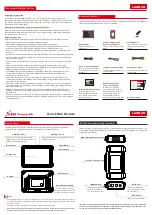
Safety instructions
14
Edition 05/2014
PlasmaQuant PQ 9000
2.6.8
Handling of samples, auxiliary and operating materials
Observe the following notes:
The operator is responsible for the selection of substances used in the process as well as
for their safe handling. This is particularly important for radioactive, infectious, poisonous,
corrosive, combustible, explosive and otherwise dangerous substances.
When handling dangerous substances, local safety codes and guidelines must be
observed.
Warnings on the labels must always be observed. Only use clearly marked containers as
well as protective goggles and rubber gloves. Use suitable body protection (coat, safety
glasses and rubber gloves) when handling samples. Ensure sufficient ventilation.
Cleaning with hydrofluoric acid must be carried out in an
exhaust chamber
. When
handling hydrofluoric acid,
rubber aprons, gloves
and
face masks
must be worn.
Biological samples
must be handled according to local guidelines regarding the handling
of infectious material.
When measuring
material containing cyanide
, you have to make sure that
prussic acid
cannot be generated in the waste bottle, i.e., the waste solution must not be acidic.
Ensure that all residue liquid from the nebulizer and the automatic sampler is directed into
the waste bottle supplied.
The operator is responsible for ensuring that
waste materials
such as drained coolant and
residue liquid from the waste bottle are disposed of in an environmentally responsible
manner and according to local regulations.
Examples of dangerous organic solvents
Methyl isobutyl ketone (MIBK)
Flammable, highly volatile, noxious-smelling
Toluene
Flammable, hazardous to health
Kerosene
Flammable, hazardous to the aquatic environment,
hazardous to health
Methanol, ethanol, propanol
Flammable, partly acutely toxic
Tetrahydrofuran (THF)
Flammable, hazardous to health, extremely volatile,
dissolves polyethylene and polystyrene
This list is in so far incomplete that other solvents could also come into consideration for use in
the PlasmaQuant PQ 9000. In cases of uncertainty about an unnamed fluid, this may only be
used when the manufacturer has confirmed that there is no danger to safety.
2.6.9
Safety instructions relating to cleaning and decontamination measures in
case of biological contamination
Observe the following notes:
The operator is responsible for carrying out suitable decontamination should the device be
contaminated externally or internally with dangerous substances.
Spots, drops or larger spillages should be removed and cleaned using an absorbent
material such as cotton wool, laboratory wipes or cellulose. The affected areas must then
be wiped with an Incidin Plus solution.
Before using a cleaning or decontamination procedure other than that prescribed by the
manufacturer, the user is required to check with the manufacturer that the intended
procedure will not damage the device. Safety labels attached to the PlasmaQuant PQ 9000
must not be wetted by methanol.
















































